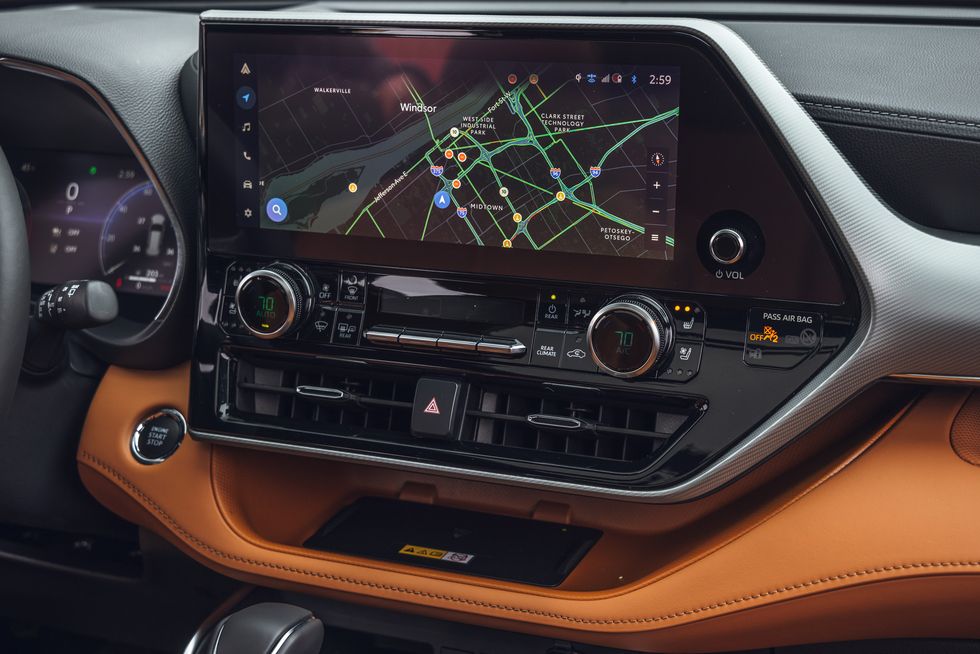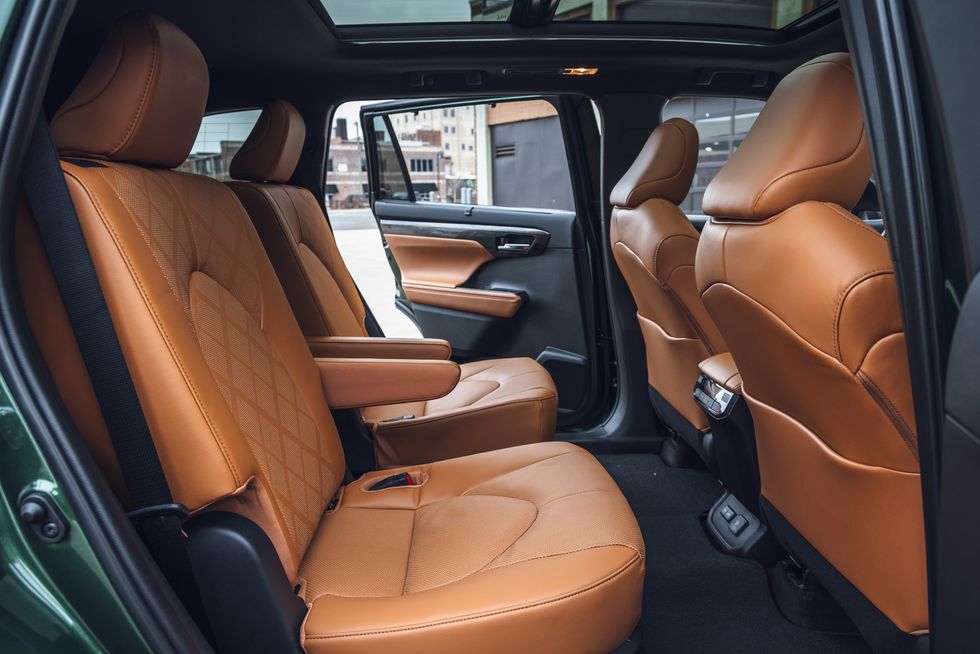After laboring away under the hood of countless Camrys, Siennas, Highlanders, and many other models, Toyota’s 3.5-liter V-6 is slowly being ushered off stage. In a move common throughout the industry, a turbocharged four is supplanting the naturally aspirated V-6. With the 2023 model year, the Highlander joins the four-cylinder club, but it’s a change that Toyota is making as invisible as possible.
With a drop in cylinder count comes a drop in horsepower, now 265 ponies versus 295 before. But the turbocharger delivers a compensating boost in torque, which rises to 310 pound-feet from 263. Still, with 4529 pounds to move, the turbo four strains at times, holding lower gears when a burlier V-6 might confidently upshift. That impression of a hard-working turbo four is born out in our testing of an all-wheel-drive Platinum. The smaller engine’s 7.2-second 60-mph time lags 0.5 behind the number for the all-wheel-drive V-6, and the same was true with a rolling start in our 5-to-60-mph test.
In the Highlander, the step-up powertrain offering (at a cost of $1400 in most trim levels) is a four-cylinder hybrid. With a total of 243 horsepower, the gas-electric combo nearly matched the acceleration performance of the turbo four in the run to 60 mph. The Highlander hybrid (again with all-wheel drive) was just a tick behind the 2.4T to 60 mph at 7.3 seconds, but it fell further behind in the 50-to-70-mph passing test, taking 5.2 seconds to the turbo four’s 4.7.
So, the 2.4 turbo can’t quite match the V-6 in acceleration but stays (just barely) ahead of the hybrid. The new engine’s drivability, though, is above reproach. The turbo’s boost is smoothly integrated, and response is quite linear for a boosted four. At low speeds on rolling terrain when you’re just grazing the throttle, some turbocharged engines can surge unevenly, but not this one. It helps that Toyota pairs the boosted engine with a well-behaved eight-speed automatic rather than a CVT as in the Subaru Ascent. Additionally, Toyota claims the new engine is good for the same 5000-pound towing capacity as the V-6.
We just wish the engine sounded happier in its work. Once the engine reaches 3000 rpm or so, the four-banger’s machinations are less than melodious. It quiets right down when cruising, though, and we recorded 68 decibels at a steady 70 mph, marginally better than the V-6.
The benefit you’d expect from engine downsizing is improved fuel economy, and the 2023 Highlander’s gas mileage does improve, just not by a lot. With all-wheel drive, the Highlander 2.4T’s EPA estimates are 24 mpg combined, 21 city, and 28 highway, which amounts to just 1 mpg better than the previous V-6 across the board. (The front-wheel-drive version ekes out another 1 mpg in all three measures.) The Highlander hybrid is the real gas-mileage champ, with EPA combined estimates of 35 mpg for all-wheel drive and 36 mpg for front-wheel drive, numbers that lead the field.
Aside from the engine swap, the Highlander’s driving experience is largely unchanged. The ride is composed, and the body structure feels solid even when you thwack into a pothole that reveals itself at the last minute. The steering, though, doesn’t feel connected to anything beyond the firewall (and switching to Sport mode doesn’t help, as that only affects the powertrain). We understand this isn’t the type of machine that’s likely to be chosen for Sunday-morning canyon carving, but a better-tuned helm would be welcome even in more mundane commuting, such as when you’re riding close to the concrete barriers in construction-narrowed lanes. Handling is neither particularly sporty nor clumsy—about what you’d expect from a family-size SUV—and skidpad grip at 0.84 g is in line with competitors. Hit the brakes, and the Highlander hauls itself down from 70 mph in 170 feet, a solid performance (although not quite as good as what we recorded with the 2023 Hyundai Palisade).
Inside the well-finished cabin, the 2023 model year brings a few tech updates. The Limited and Platinum get a digital instrument cluster, and Toyota’s latest infotainment system makes its debut here. Standard on the Limited and Platinum and optional on the XSE and XLE, the broad, 12.3-inch touchscreen is perched high on the center dash and boasts a lag-free processor and sharp graphics. The volume knob is a far reach, and we miss having a tuning knob, but that’s a fast-disappearing amenity these days. The driver instead interacts with the audio system via the steering-wheel buttons. With so much screen real estate, we’d also like to have the ability to show multiple functions at once, but that’s only possible when using Android Auto or Apple CarPlay, both of which are wireless.
Below the screen, the physical climate controls have a good separation of function, making the system easy to use. And below that is a shelf for your phone, which now offers wireless charging (previously the wireless charger was awkwardly located in the console storage box). As before, there’s another handy shelf on the passenger’s side of the dash.
As in all mid-size SUVs, the Highlander’s second-row captain’s chairs are plenty roomy for adults, and buyers alternately can also choose a middle-row bench seat in four of the six trim levels. The picture is less rosy in the rearmost seat, where the low cushion forces a knees-up seating position, while legroom ranges from tolerable to almost nonexistent, depending on the position of the middle-row seats. And don’t expect to carry much luggage with the third row in use. If you regularly use the third row, there are roomier choices in this segment—the Chevrolet Traverse and the Volkswagen Atlas, to name just two. Toyota clearly is cognizant of this shortcoming, as it’s introducing the longer and roomier Grand Highlander for those who regularly carry a crowd.
This year’s engine swap hasn’t altered our opinion of the Highlander by a whole lot. The V-6 was a stronger performer, but the turbo four is adequate. The 2.4T gets better mileage, but not much better. We continue to think that the Highlander hybrid, with its stellar gas mileage, is the way to go. And of the Highlander’s plethora of trim levels, all but two of them give you that choice.
Specifications
Specifications
2023 Toyota Highlander Platinum AWD
Vehicle Type: front-engine, all-wheel-drive, 7-passenger, 4-door wagon
PRICE
Base/As Tested: $52,560/$54,372
Options: Running boards, $599; dashcam, $375; carpeted floor and cargo mats, $358; roof-rack cross bars, $350; door edge guards, $130
ENGINE
Turbocharged and intercooled DOHC 16-valve inline-4, aluminum block and head, port and direct fuel injection
Displacement: 146 in3, 2393 cm3
Power: 265 hp @ 6000 rpm
Torque: 310 lb-ft @ 1700 rpm
TRANSMISSION
8-speed automatic
CHASSIS
Suspension, F/R: struts/multilink
Brakes, F/R: 13.3-in vented disc/13.3-in disc
Tires: Goodyear Eagle Touring
235/55R-20 102V M+S
DIMENSIONS
Wheelbase: 112.2 in
Length: 194.9 in
Width: 76.0 in
Height: 68.1 in
Passenger Volume, F/M/R: 55/49/31 ft3
Cargo Volume, Behind F/M/R: 84/48/16 ft3
Curb Weight: 4529 lb
C/D TEST RESULTS
60 mph: 7.2 sec
1/4-Mile: 15.5 sec @ 92 mph
100 mph: 18.5 sec
Results above omit 1-ft rollout of 0.3 sec.
Rolling Start, 5–60 mph: 7.7 sec
Top Gear, 30–50 mph: 3.5 sec
Top Gear, 50–70 mph: 4.7 sec
Top Speed (gov ltd): 113 mph
Braking, 70–0 mph: 170 ft
Roadholding, 300-ft Skidpad: 0.84 g
C/D FUEL ECONOMY
Observed: 21 mpg
EPA FUEL ECONOMY
Combined/City/Highway: 24/21/28 mpg

Deputy Editor, Reviews and Features
Joe Lorio has been obsessed with cars since his Matchbox days, and he got his first subscription to Car and Driver at age 11. Joe started his career at Automobile Magazine under David E. Davis Jr., and his work has also appeared on websites including Amazon Autos, Autoblog, AutoTrader, Hagerty, Hemmings, KBB, and TrueCar.


